AMD’s Radeon HD 5770 & 5750: DirectX 11 for the Mainstream Crowd
by Ryan Smith on October 13, 2009 12:00 AM EST- Posted in
- GPUs
Power, Temperature, & Noise
With the 5700 series being built using TSMC’s 40nm process, and with their low target power, we should see some interesting results here.
We do need to note however that thanks to some badly timed broken hardware, we’re using our secondary test rig for noise and temperature data, so the results are not directly comparable to our 5800 series reviews. As a result we also only have power data for the 5770; we weren’t able to get power data on the 5750 in time for this article.
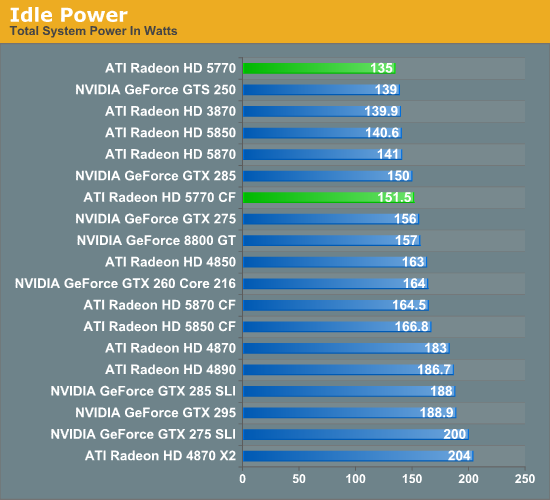
Thanks to the 40nm process and relatively simple nature of Juniper, the 5770 turns in the best idle power usage of all of our mainstream and high-end cards. At 135W it edges out the GTS 250, the 3870, and its bigger brothers the 5800 series. Coupled with a good CPU, and this should result in a system with very good idle power usage for the performance levels it provides.
We can also see the low power usage of an individual 5770 in our 5770 CF usage. There's a 16.5W difference, as the slave card gets to power down even further than 18W.

At 256W for load power, the 5770 isn’t quite the winner here like it is for idle power. The 3870 beats it by 14W at the cost of a significant degree of performance, while the 8800GT is neck-and-neck with the 4770, again with a decent-sized performance gap. Everything past here approaches 300W and beyond. As a result, even if it’s not the least power hungry card we have, it’s very close, and it’s certainly among the best for on a power-to-performance ratio.
Meanwhile looking at the Crossfire results, we see that there's a 134W difference between cards. As the Evergreen architecture allows us to go higher so long as the VRMs are safe, this appears to that situation in action.
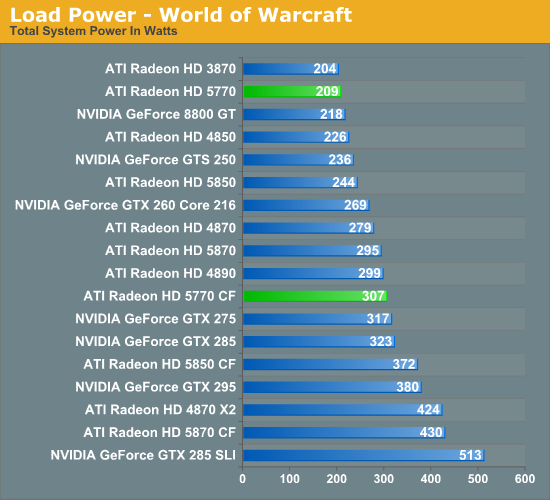
World of Warcraft gives us similar results. The 5770 still doesn’t come out on top, but its bested only by the 3870 and its significantly lower performance. The gap on the other side isn’t particularly large either, but the first card that can beat the 5770’s average gaming performance doesn’t show up until we hit the 5850.
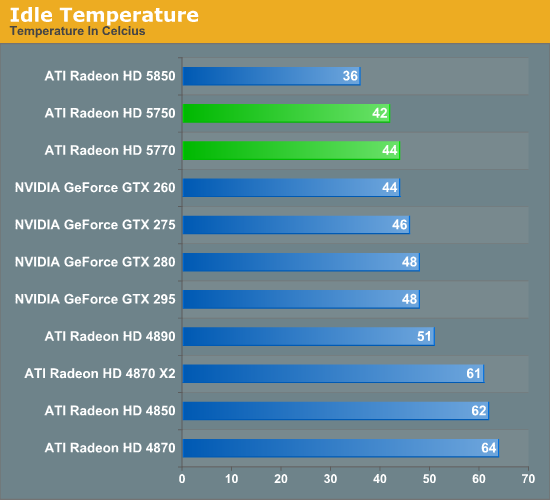
The 5700 series turns in some of our best idle temps, tying or beating everything besides a 5850. In fact we’re a bit surprised to see a 5850 win here given the lower idle power usage of the 5700 series, but the data doesn’t lie.
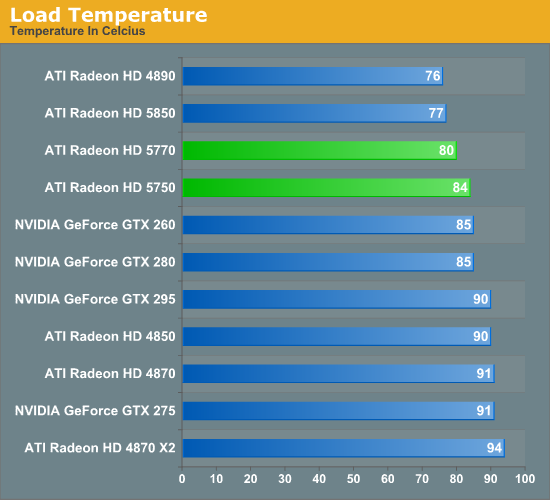
It’s load temperatures where all of the action is at. Again the 5700 series do quite well here, only losing to the 5850 and a very loud 4890. Compared to the rest of the 4800 series in particular, we’re a good 6C-11C cooler for a set of cards that offer similar to slightly less performance. Aren’t smaller manufacturing processes great?
However in spite of the 5750’s lower power consumption, it doesn’t do so well here in terms of temperature compared to the 5770, coming in 4C hotter. We’re going to chalk it up to the egg cooler being unable to match the 5770’s shrouded cooler. This of course makes the fact that the 5770’s shrouded cooler is going to eventually go away all the more meaningful, as conceivably the replacement coolers would end up being less effective.
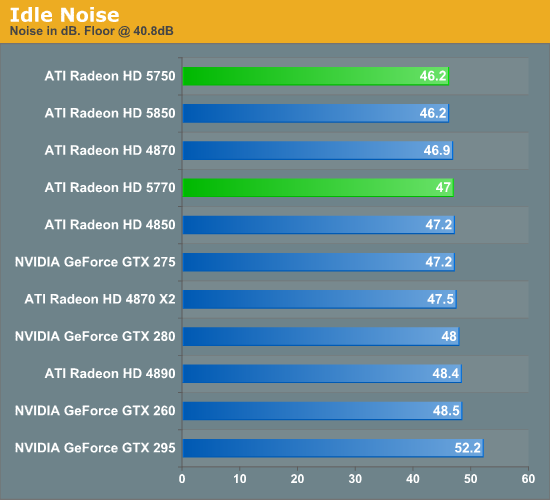
As is the case for most of the cards we test, at idle they’re virtually all the same. The 5700 series are no exception to this rule.
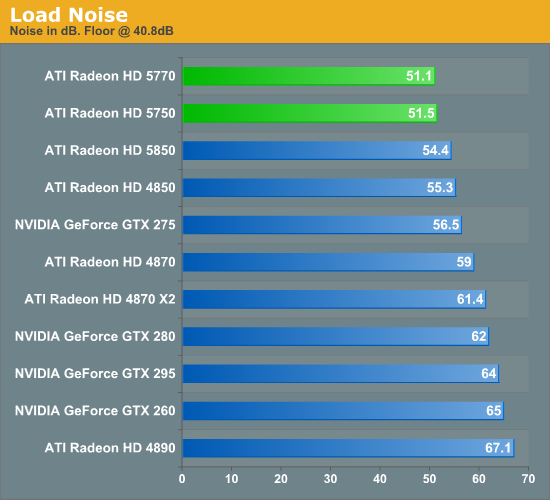
With the low power consumption of the 5700 series, their coolers don’t have to work very hard to reach their already low load temperatures. At 51dB, these are the quietest cards we’ve tested at this level of performance; we would need to drop down to something slower yet (like yesterday’s GT 220) to find something quieter.
We also can’t rule out the possibility of the 5750 going passive in the future, given its already dainty cooler. We’ve seen it done before on an 8800GT, which has a similar thermal envelope. This certainly has all the makings of the fastest passively cooled card on the market, if someone can build the right cooler.
This also leaves the door open to the idea of using the 5750 as an HTPC card. With bitstreaming audio support it’s the best HTPC card we’ve tested yet from a features standpoint, but we’re not convinced that it’s going to be the best thing out there given it’s >$100 price tag and the fact that it’s still power-hungry enough to need a PCIe power connector. In the long-term the 5600 series may be a better replacement given the same features and lower power consumption that a lower-performing part will offer, but that’s something we won’t be able to test until next year.










117 Comments
View All Comments
papapapapapapapababy - Saturday, October 17, 2009 - link
http://ht4u.net/reviews/2009/amd_ati_radeon_hd_570...">http://ht4u.net/reviews/2009/amd_ati_radeon_hd_570...use babel
Zool - Wednesday, October 14, 2009 - link
The 5700 series have the same improved adaptive antialiasing with shaders like the 5800 series ?There could be a antialiasing graph with diferent resoutions and antialiasing types for each card in reviews.
RDaneel - Wednesday, October 14, 2009 - link
I may be in the minority, but I've already ordered a 5750. For a SOHO box used for only occasional gaming, it was the most future-proofed option (DX11) that also has low enough idle draw that it actually will save me enough money over the life of the card to justify any price difference with a 48xx card. Would I have loved 10% more performance, sure, but this isn't a bad blend of efficiency and longevity.yacoub - Wednesday, October 14, 2009 - link
imho, it's perfect for that situation.Those of us who have a gaming PC with a DX10 card in it are the ones who find this 5700 series less than stellar.
ET - Thursday, October 15, 2009 - link
But those of us that have a mid-range PC with yesteryear's DX10 card (3870) find it appealing. :)SantaAna12 - Wednesday, October 14, 2009 - link
are you filtering out comments these days?SantaAna12 - Wednesday, October 14, 2009 - link
what up AT?ive been lookin at your recent AMD rants, and its getting tiresome. They paying u the big bucks these days? when you only compare AMD cards against AMD cards you are doing your site a disservice. When you show CF but no SLI you are showing me a new AT.
I have expected more in the past. You goin the route of TOMS?
Ryan Smith - Wednesday, October 14, 2009 - link
As we noted in the article, the CF configuration is mostly for academic reasons. I don't seriously expect anyone to pick it over a single card.Anyhow, what would you like to see? I have the SLI data for the 275 and the 285, but since we've already established that the 260C216 is faster than the 5770, it won't really tell you anything useful.
just4U - Wednesday, October 14, 2009 - link
"NVIDIA would need to shave the price down to justify its purchase once more (something they have not done on the GTX series in response to the 5870 and 5850)."------------------
I'd like to comment on this for just a moment. Where I live we haven't seen much stock on the new dx11 cards yet.. however, Suddenly there's a slew of highly priced 295's and other top end Nvidia products that these stores were not stocking.
My bet is that .. people walking in and making a purchase find out that they can't get that coveted new DX11 card so they opt out for one of those. So in a sense Nvidia would be riding on the coattails of Ati's new popular line that .. just doesn't have the availability. They haven't had to lower prices yet because they may be benifiting by the lack of stocked cards.
Make sense?
Ananke - Wednesday, October 14, 2009 - link
No, it doesn't make sense :)Why would you spent 3-400 for something that you don't want at first place? Why just not keep your money until you actually can buy what you want? We are not talking about 10 bucks, it is way bigger chunk...